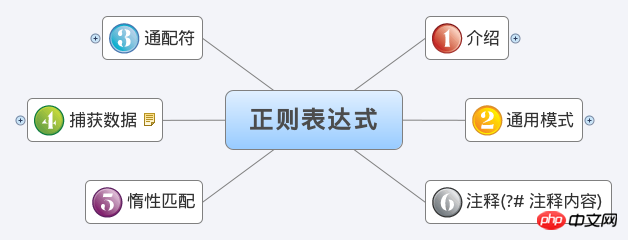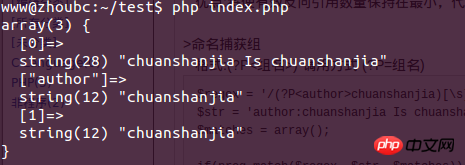Basics of getting started with PHP regular expressions
正则表达式,大家在开发中应该是经常用到,现在很多开发语言都有正则表达式的应用。本文给大家介绍PHP正则表达式入门教程,感兴趣的朋友一起学习吧
思维导图

点击下图,可以看具体内容!
介绍
正则表达式,大家在开发中应该是经常用到,现在很多开发语言都有正则表达式的应用,比如javascript,java,.net,php等等,我今天就把我对正则表达式的理解跟大家唠唠,不当之处,请多多指教!
定位
我们什么时候使用正则表达式呢?不是所有的字符操作都用正则就好了,php在某些方面用正则反而影响效率。当我们遇到复杂文本数据的解析时候,用正则是比较好的选择。
优点
正则表达式在处理复杂字符操作的时候,可以提高工作效率,也在一定程度节省你的代码量。
缺点
我们在使用正则表达式的时候,复杂的正则表达式会加大代码的复杂度,让人很难理解。所以我们有的时候需要在正则表达式内部添加注释。
通用模式
¤ 定界符,通常使用 "/"做为定界符开始和结束,也可以使用"#"。
什么时候使用"#"呢?一般是在你的字符串中有很多"/"字符的时候,因为正则的时候这种字符需要转义,比如uri。
使用"/"定界符的代码如下.
$regex = '/^http:\/\/([\w.]+)\/([\w]+)\/([\w]+)\.html$/i';
$str = 'http://www.youku.com/show_page/id_ABCDEFG.html';
$matches = array();
if(preg_match($regex, $str, $matches)){
var_dump($matches);
}
echo "\n";preg_match中的$matches[0]将包含与整个模式匹配的字符串。
使用"#"定界符的代码如下.这个时候对"/"就不转义!
$regex = '#^http://([\w.]+)/([\w]+)/([\w]+)\.html$#i';
$str = 'http://www.youku.com/show_page/id_ABCDEFG.html';
$matches = array();
if(preg_match($regex, $str, $matches)){
var_dump($matches);
}
echo "\n";¤ 修饰符:用于改变正则表达式的行为。
我们看到的('/^http:\/\/([\w.]+)\/([\w]+)\/([\w]+)\.html/i')中的最后一个"i"就是修饰符,表示忽略大小写,还有一个我们经常用到的是"x"表示忽略空格。
贡献代码:
$regex = '/HELLO/';
$str = 'hello word';
$matches = array();
if(preg_match($regex, $str, $matches)){
echo 'No i:Valid Successful!',"\n";
}
if(preg_match($regex.'i', $str, $matches)){
echo 'YES i:Valid Successful!',"\n";
}¤ 字符域:[\w]用方括号扩起来的部分就是字符域。
¤ 限定符:如[\w]{3,5}或者[\w]*或者[\w]+这些[\w]后面的符号都表示限定符。现介绍具体意义。
{3,5}表示3到5个字符。{3,}超过3个字符,{,5}最多5个,{3}三个字符。
* 表示0到多个
+ 表示1到多个。
¤ 脱字符号
^:
> 放在字符域(如:[^\w])中表示否定(不包括的意思)——“反向选择”
> 放在表达式之前,表示以当前这个字符开始。(/^n/i,表示以n开头)。
注意,我们经常管"\"叫"跳脱字符"。用于转义一些特殊符号,如".","/"
通配符(lookarounds):断言某些字符串中某些字符的存在与否!
lookarounds分两种:lookaheads(正向预查 ?=)和lookbehinds(反向预查?<=)。
> 格式:
正向预查:(?=) 相对应的 (?!)表示否定意思
反向预查:(?<=) 相对应的 (?
前后紧跟字符
$regex = '/(?<=c)d(?=e)/'; /* d 前面紧跟c, d 后面紧跟e*/
$str = 'abcdefgk';
$matches = array();
if(preg_match($regex, $str, $matches)){
var_dump($matches);
}
echo "\n";否定意义:
$regex = '/(?<!c)d(?!e)/'; /* d 前面不紧跟c, d 后面不紧跟e*/
$str = 'abcdefgk';
$matches = array();
if(preg_match($regex, $str, $matches)){
var_dump($matches);
}
echo "\n";>字符宽度:零
验证零字符代码
$regex = '/HE(?=L)LO/i';
$str = 'HELLO';
$matches = array();
if(preg_match($regex, $str, $matches)){
var_dump($matches);
}
echo "\n";打印不出结果!
$regex = '/HE(?=L)LLO/i';
$str = 'HELLO';
$matches = array();
if(preg_match($regex, $str, $matches)){
var_dump($matches);
}
echo "\n";能打印出结果!
说明:(?=L)意思是HE后面紧跟一个L字符。但是(?=L)本身不占字符,要与(L)区分,(L)本身占一个字符。
捕获数据
没有指明类型而进行的分组,将会被获取,供以后使用。
> 指明类型指的是通配符。所以只有圆括号起始位置没有问号的才能被捕捉。
> 在同一个表达式内的引用叫做反向引用。
> 调用格式: \编号(如\1)。
$regex = '/^(Chuanshanjia)[\w\s!]+\1$/';
$str = 'Chuanshanjia thank Chuanshanjia';
$matches = array();
if(preg_match($regex, $str, $matches)){
var_dump($matches);
}
echo "\n";> 避免捕获数据
格式:(?:pattern)
优点:将使有效反向引用数量保持在最小,代码更加、清楚。
>命名捕获组
格式:(?P<组名>) 调用方式 (?P=组名)
$regex = '/(?P<author>chuanshanjia)[\s]Is[\s](?P=author)/i';
$str = 'author:chuanshanjia Is chuanshanjia';
$matches = array();
if(preg_match($regex, $str, $matches)){
var_dump($matches);
}
echo "\n";运行结果

惰性匹配(记住:会进行两部操作,请看下面的原理部分)
格式:限定符?
原理:"?":如果前面有限定符,会使用最小的数据。如“*”会取0个,而“+”会取1个,如过是{3,5}会取3个。
先看下面的两个代码:
代码1.
<?php
$regex = '/heL*/i';
$str = 'heLLLLLLLLLLLLLLLL';
if(preg_match($regex, $str, $matches)){
var_dump($matches);
}
echo "\n";结果1.

代码2
<?php
$regex = '/heL*?/i';
$str = 'heLLLLLLLLLLLLLLLL';
if(preg_match($regex, $str, $matches)){
var_dump($matches);
}
echo "\n";结果2

代码3,使用“+”
<?php
$regex = '/heL+?/i';
$str = 'heLLLLLLLLLLLLLLLL';
if(preg_match($regex, $str, $matches)){
var_dump($matches);
}
echo "\n";结果3

代码4,使用{3,5}
<?php
$regex = '/heL{3,10}?/i';
$str = 'heLLLLLLLLLLLLLLLL';
if(preg_match($regex, $str, $matches)){
var_dump($matches);
}
echo "\n";结果4

正则表达式的注释
格式:(?# 注释内容)
用途:主要用于复杂的注释
贡献代码:是一个用于连接MYSQL数据库的正则表达式
$regex = '/
^host=(?<!\.)([\d.]+)(?!\.) (?#主机地址)
\|
([\w!@#$%^&*()_+\-]+) (?#用户名)
\|
([\w!@#$%^&*()_+\-]+) (?#密码)
(?!\|)$/ix';
$str = 'host=192.168.10.221|root|123456';
$matches = array();
if(preg_match($regex, $str, $matches)){
var_dump($matches);
}
echo "\n";特殊字符
| 特殊字符 | 解释 |
| * | 0到多次 |
| + | 1到多次还可以写成{1,} |
| ? | 0或1次 |
| . | 匹配除换行符外的所有单个的字符 |
| \w | [a-zA-Z0-9_] |
| \s | 空白字符(空格,换行符,回车符)[\t\n\r] |
| \d | [0-9] |
总结:以上就是本篇文的全部内容,希望能对大家的学习有所帮助。
相关推荐:
The above is the detailed content of Basics of getting started with PHP regular expressions. For more information, please follow other related articles on the PHP Chinese website!

Hot AI Tools

Undresser.AI Undress
AI-powered app for creating realistic nude photos

AI Clothes Remover
Online AI tool for removing clothes from photos.

Undress AI Tool
Undress images for free

Clothoff.io
AI clothes remover

AI Hentai Generator
Generate AI Hentai for free.

Hot Article

Hot Tools

Notepad++7.3.1
Easy-to-use and free code editor

SublimeText3 Chinese version
Chinese version, very easy to use

Zend Studio 13.0.1
Powerful PHP integrated development environment

Dreamweaver CS6
Visual web development tools

SublimeText3 Mac version
God-level code editing software (SublimeText3)

Hot Topics
 CakePHP Project Configuration
Sep 10, 2024 pm 05:25 PM
CakePHP Project Configuration
Sep 10, 2024 pm 05:25 PM
In this chapter, we will understand the Environment Variables, General Configuration, Database Configuration and Email Configuration in CakePHP.
 PHP 8.4 Installation and Upgrade guide for Ubuntu and Debian
Dec 24, 2024 pm 04:42 PM
PHP 8.4 Installation and Upgrade guide for Ubuntu and Debian
Dec 24, 2024 pm 04:42 PM
PHP 8.4 brings several new features, security improvements, and performance improvements with healthy amounts of feature deprecations and removals. This guide explains how to install PHP 8.4 or upgrade to PHP 8.4 on Ubuntu, Debian, or their derivati
 CakePHP Date and Time
Sep 10, 2024 pm 05:27 PM
CakePHP Date and Time
Sep 10, 2024 pm 05:27 PM
To work with date and time in cakephp4, we are going to make use of the available FrozenTime class.
 CakePHP File upload
Sep 10, 2024 pm 05:27 PM
CakePHP File upload
Sep 10, 2024 pm 05:27 PM
To work on file upload we are going to use the form helper. Here, is an example for file upload.
 Discuss CakePHP
Sep 10, 2024 pm 05:28 PM
Discuss CakePHP
Sep 10, 2024 pm 05:28 PM
CakePHP is an open-source framework for PHP. It is intended to make developing, deploying and maintaining applications much easier. CakePHP is based on a MVC-like architecture that is both powerful and easy to grasp. Models, Views, and Controllers gu
 CakePHP Routing
Sep 10, 2024 pm 05:25 PM
CakePHP Routing
Sep 10, 2024 pm 05:25 PM
In this chapter, we are going to learn the following topics related to routing ?
 CakePHP Working with Database
Sep 10, 2024 pm 05:25 PM
CakePHP Working with Database
Sep 10, 2024 pm 05:25 PM
Working with database in CakePHP is very easy. We will understand the CRUD (Create, Read, Update, Delete) operations in this chapter.
 CakePHP Creating Validators
Sep 10, 2024 pm 05:26 PM
CakePHP Creating Validators
Sep 10, 2024 pm 05:26 PM
Validator can be created by adding the following two lines in the controller.






